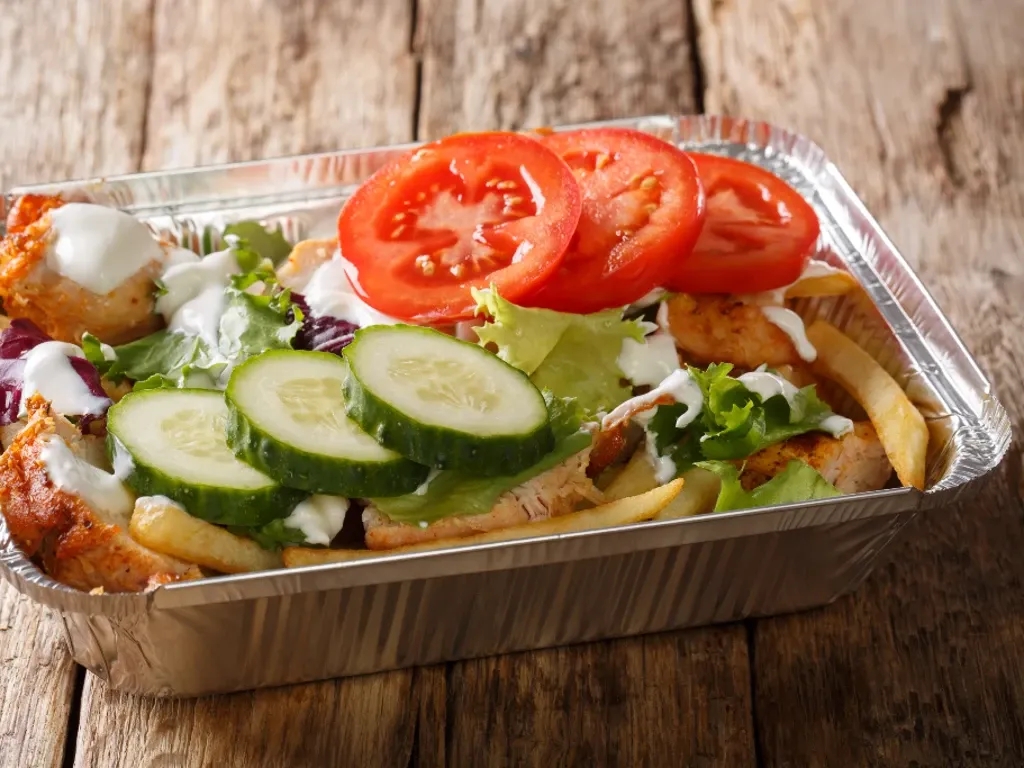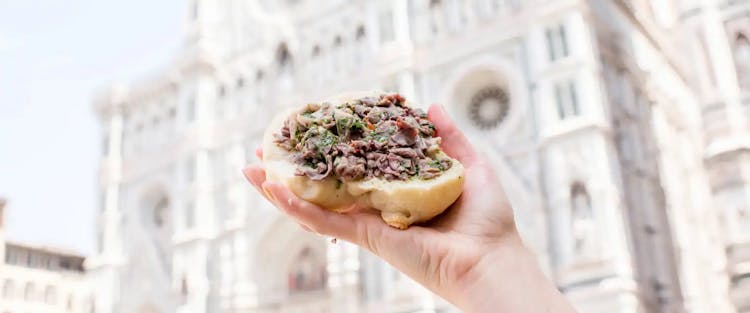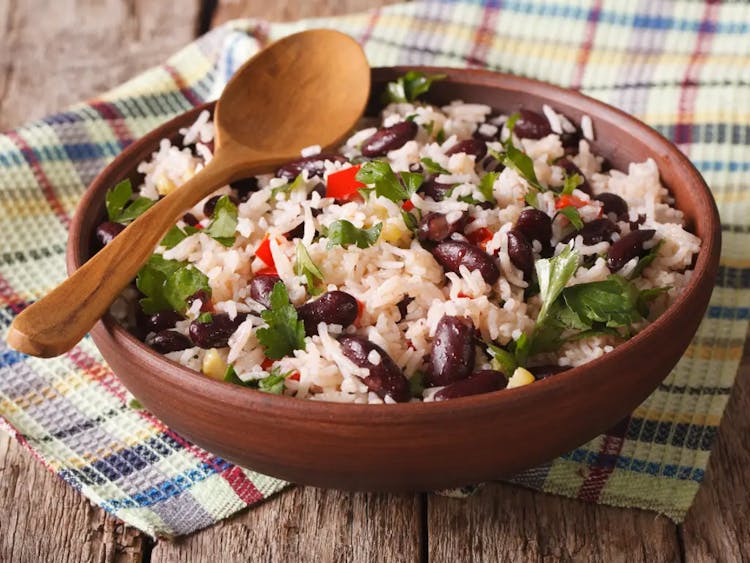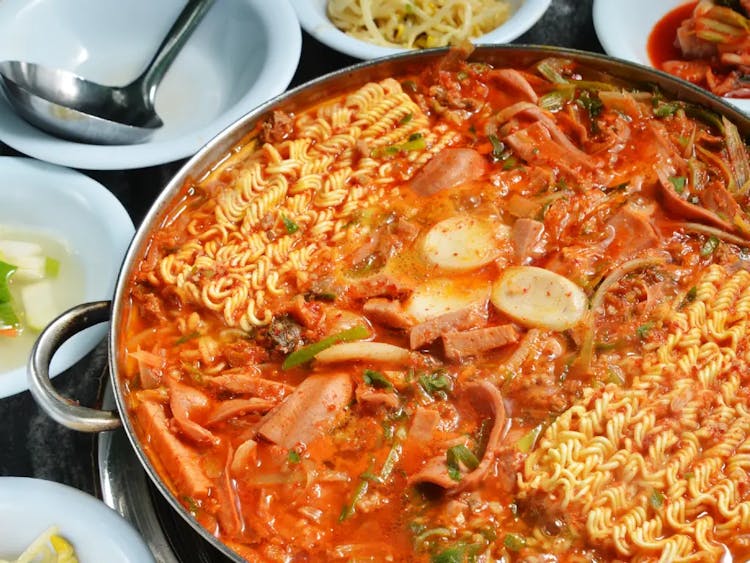
Kapsalon: A Delicious Cultural Collision Rooted in Rotterdam
When I moved to Amsterdam in 2018, I enrolled in Dutch classes and began mentally translating every word of Dutch I saw, from street signs to menus to the aisles at grocery stores. The language sometimes baffled me. I was particularly perplexed when I started noticing the word “kapsalon” on the menu boards of shawarma shops around town. I was sure kapsalon meant hair salon. Was this a looming snack stand–barbershop collaboration trend?
Turns out kapsalon is, in fact, a favorite Dutch takeout dish. Served in an aluminum container, it starts with a layer of fries covered in shawarma (or donër) meat and cheese; then, it’s quickly broiled. All of that is buried under shredded lettuce and other salad vegetables, like cucumbers, tomatoes, and onions. Finally, it’s slathered in garlic sauce and sambal, an Indonesian chili paste.

This food story gets a little hairy
What does any of this have to do with hair salons? Only that a hairdresser was the first to request this particular combination of ingredients back in 2003. Nathaniël Gomes, who worked at Kapsalon Tati in Rotterdam’s Delfshaven neighborhood, requested all his favorite things in one container at the nearby El Aviva snack bar. He came back to repeat the order so often that the shop put it on the menu and named the dish after him.
However, this combination wouldn’t have been available without the people—and cultures—that came before Gomes and still live alongside one another in Rotterdam today. Gomes, a hairdresser of Cape Verdean heritage, created it in collaboration with Dervis Bengü, the Turkish snack bar owner. And the dish itself combines Middle Eastern, Dutch, and Indonesian flavors.
All of this offers insight into what it means to be a real Rotterdammer, says Paul van de Laar, who studies urban history at Erasmus University. He recently co-authored a book titled De Echte Rotterdammer komt van buiten—which literally translates to “the real Rotterdammer comes from outside”—arguing that Rotterdam has seen so much migration over the past 400 years that it has become a “super-diverse” city where it is no longer reasonable to talk about minority or majority populations and culture. He uses kapsalon as a case study of Rotterdam’s postcolonial identity. “I identified kapsalon as the cultural heritage of the future,” he tells me.

The spread of kapsalon
In the 20 years since it landed on El Aviva’s menu, this dish has indeed become part of Dutch culture. It was one of the most popular dishes throughout the country for home delivery in 2022, according to food delivery company Thuisbezorgd and, despite the garlic sauce, was the most popular dish nationwide on Valentine’s Day.
Although kapsalon is now popular throughout the Netherlands, the city of Rotterdam still proudly claims this dish as its own. Museum Rotterdam has granted the kapsalon Authentic Rotterdam Heritage status. Rotterdam Central Station is even nicknamed Station Kapsalon because its structure resembles a take-out dish.
“We see this as a unique Rotterdam dish, which came into existence because people with different cultural backgrounds are living and working in the same area,” says Nicole van Dijk, a curator at Museum Rotterdam.
So when an Amsterdam shawarma shop sign proclaimed kapsalon an “Amsterdam specialty” in 2019, a minor war of words ensued between the two cities. Van de Laar shared his feelings on the matter with Dutch newspaper Het Parool, which (translated from Dutch to English) essentially said it was a “self-overestimation of the capital city.”
In actuality, it was an honest mistake. The dish has become so ubiquitous that the owner of the Amsterdam shop didn’t really think about its origin when he made his sign. Still, talking to TV station AT5, he couldn’t resist throwing in a little jab: “Maybe you could say: The kapsalon comes from Rotterdam, but in Amsterdam we make the dish better.”
In truth, there’s very little variation in the dish across the country or even across borders as it extends its territory into Belgium and Germany. With kapsalon, what you see is what you get—just like Gomes ordered 20 years ago.
Looking forward and thinking back
I first tried kapsalon at Saray snack bar on Javaplein in East Amsterdam. My method for choosing this spot was simple—it was right around the corner from my apartment, and there was always a line out the door. Plus, they offered a version made with falafel instead of meat (I’m vegetarian), and the photo menu meant I couldn’t make a mistake with my still-basic Dutch. All I had to do was order the number 13.
As I dug in, I realized kapsalon is everything you’d want in a late-night snack or hangover cure. It’s hot and cold, chewy and crunchy, salty and fresh and fatty with a little punch of garlic and chili heat. It is also enormous. While my falafel version might have been slightly lighter, a regular kapsalon averages around 1,800 calories. This is not a dish to eat daily, but it is the ultimate comfort food to get you through a wet and cold Dutch winter or fuel your bike ride home after a night on the town.
However, kapsalon is not unique in its medley of multiculturalism. Consider patatje oorlog—“war fries”—yet another example of the Dutch’s love for fries. This time, though, the fries are buried under mayonnaise, satay sauce, and diced raw onions. Indonesian ingredients like sambal and satay sauce are well integrated into Dutch cuisine through colonial ties, but colonial history is complicated, and the Netherlands continues to reckon with its imperialist past. It’s important to acknowledge the ways food and culture come together in the Netherlands—I had enjoyed many a rijsttafel and nasi goreng before I understood the colonial pathways that brought these dishes to the country in which I lived.
In contrast, the kapsalon feels like a modern and hopeful approach to the collisions of culture now happening in the Netherlands: Throw it all together and it becomes something greater than the sum of its parts.
Just don’t forget the napkins.

Where to try kapsalon in the Netherlands
In Rotterdam
The birthplace of the kapsalon. It’s still a prime place to try this Dutch calorie bomb.
If you prefer your kapsalon on a plate rather than scarfing it out of a takeout container, head to this halal shawarma shop and order the golden kapsalon.
In Amsterdam
Saray
Located at Javaplein 18 in East Amsterdam, this popular spot doesn’t need a website to drive a line out the door.
Foodhallen is a delightful assembly of food stalls in a historic tram station. At Píta, pick up a “reversed” kapsalon, where the fries appear on top, and grab a spot at one of the long tables for some great people watching.
Sure, this is not traditional—but it is, well, vegan. This mini-chain’s bright colors and graffiti aesthetic make it a fun place to hang out, too.
Other food guides
- Braziilan açaí
- Tahitian chow mein sandwiches
- Georgian Adjaruli khachapuri
- Marseilles Brik à L'Oeuf
- Korean budae jjigae
- Kansas City burnt ends
- German döner kebab
- Basque marmitako
- Puerto Rican mofongo
- Colombian arepas
- Mexican guacamole
- New Mexico Chimayó chile
- Italian maritozzo
- Hong Kong char siu
- Indian bhang lassi
- Ethiopia coffee
- UK chicken tikka masala
- The Tampa Cuban sandwich
Published September 14, 2023
Last updated December 19, 2023
Treat your travel to cheap flights
Most deals are 40-90% off normal prices with great itineraries from the best airlines. If it's not an amazing deal, we won't send it. Sign up for free to start getting flight alerts.




